CHANGE BECOMES US
PINKFLAG, 2013
With Matthew Simms replacing original guitarist Bruce Gilbert, the group hit Rockfield to record this set of songs inspired by demos for the band’s shelved fourth album.
NEWMAN: It was a disaster when Bruce left. The band was already at a low ebb, and it became very difficult. But because we all decided that we needed to unite to see off a challenge from our ex-manager, there was a reason for the three of us to get together, and that was the beginning of the arc that ends up with Silver/Lead.
LEWIS: Matt came in to be the second guitar player live, and everything worked extremely well. We finished a tour in San Francisco and I had become really convinced that Matthew was in the band; he wasn’t just an add-on. But our problem was we’d just released [2011’s] Red Barked Tree, so we didn’t really have any material. The one thing that we’d always had on the shelf was the material we’d released as [1981 live album] Document And Eyewitness, which represented the underdeveloped material that would have been the Wire album after 154. We wanted to take the essence of that material, bring it into the studio and for Matt to be in right from the beginning.
MATTHEW SIMMS (GUITAR): I was glad they didn’t want me to imitate Bruce’s parts on the demos, because those were big shoes to fill. Everything’s pretty quick with Wire – each of the last few records have been recorded in the same studio, Rockfield in Wales. After a week there, Colin takes it to his place to do overdubs and mixing.
NEWMAN: In the end it wasn’t the fourth Wire album, it was Change Becomes Us – we took things and made something different. Among the recent canon, I think people regard this as being the first really strong one.
______________________
WIRE
PINKFLAG, 2015
Their first self-titled record was one of their strongest, topped off by the sludgy majesty of “Harpooned”.
SIMMS: We worked on so much material – we also recorded [2016 mini-album] Nocturnal Koreans while we recorded Wire. There’s a lot of on-the-spotness, to capture that initial inspiration, to encourage the use of intuition rather than overthinking everything. Some bands have preconceived ideas of what it should or shouldn’t be, but there’s none of that in Wire – if it sounds good, it is good.
NEWMAN: I have a very specific way of working, and it has been the same since Send. I don’t use any loops. I hate ‘production’ where it’s really obvious. I write super-fast and I produce super-slow – how useless is that? All the keyboard parts and vocals I do in my studio. I don’t want to take up valuable studio time at Rockfield fiddling about with synthesisers, because I’m a rubbish keyboard player.
SIMMS: We worked out “Harpooned” live, before we went to Rockfield. Rob was a big part of that track – he’s very minimal, but he doesn’t like to play the same thing all the time, so he started playing it at half the speed. It all kicked off from there.
GREY: Maybe I was being persistent about making something new, but I just started playing this slow rhythm that seemed to fit. Each of us had the sense that it was new territory. We’d never done dead slow before – Wire tends to be frantic rather than slow, so that was a bit disconcerting. Playing it live increased its value and it became the last song of the set, which is prime position. You can’t finish on a dead slow song, conventionally, but it’s good for Wire.
NEWMAN: From my point of view, “Harpooned” is starting to become a bit of a millstone. I think we’re doing the classic Wire thing of moving on to the next thing.
______________________
SILVER/LEAD
PINKFLAG, 2017
Celebrating the band’s 40th anniversary, their 15th album continues the strong template set by the self-titled album.
LEWIS: Making Silver/Lead, we were prodigiously productive – maybe 20 songs in four or five days.
GREY: Everything had a click track on Silver/Lead, which was a new thing to do, because it gave Colin more options when he was doing the overdubbing and mixing.
NEWMAN: One of the things that’s come in is the single-note bassline, the classic root note on the one. It makes it super-moody and opens up acres of space. I worry about there being too many medium-paced tracks on this, but others don’t seem to have that concern. We’ve just released three albums in three years, and we haven’t done that since the ’70s.
SIMMS: “Sleep On The Wing” was written entirely in the studio. After being a band for 40 years, it’s cool that they can do something unexpected like that.
LEWIS: It was one of those times where we said, “Have we got another song?” And I said, “Well, I’ll have a look,” and it was literally put together on the spot.
NEWMAN: I was fiddling about on my keyboard and came up with a chord sequence that fitted with Graham’s words, so we just did it. It’s the first Wire song I’ve written on keyboards, which gives it a cleanness. Rob plays a kind of jazz rhythm on it, too, which is a departure. I think it sounds too much like Keane, but I’ve been assured it doesn’t sound anything like Keane!



